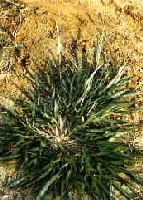View crop
View crop Data sheet EcoPortPaspalum notatum
 |
|
| Notes |
|---|
| DESCRIPTION A stout, low-growing, spreading grass with up to 30-90 cm high seed stalks with a deep rooting habit to 2-2.5 m, forming a dense, tough sod. USES It is used for pasture, hay and erosion control. It is also used as a lawn grass and it is valuable for heavy-duty turf such as is needed on airports, highway shoulders, and grass roadways. It is used as a ley in four-year rotations to reduce nematode damage to tomatoes (Lycopersicon esculentum) and peanuts (Arachis hypogaea). KILLING T Top growth is killed by frost, but established plants can tolerate temperatures down to -10 to -12°C. GROWING PERIOD Perennial, growing in spring, summer and autumn. COMMON NAMES Bahia grass, Jengi brillo, Batatais, Paraguay paspalum, Tejona, Grama dulce, Pensacola bahia grass, Rumput pencasilan, Ya-bahia, Co san dau. FURTHER INF Bahia grass is native of Central and South America, particularly southern Brazil. It can be found at elevations between sea level and 2000 m and between latitudes 25°N and 30°S. It is drought hardy. Dry matter yields are usually between 3-8 t/ha, but can be up to 20 t/ha. | Sources |
| Grassland Index Skerman P 1990 pp 571-575 [DRA, TEXT, TEMP, KTMP, RAIN, DEP, TEXT, LIG] Rehm S 1991 pp 412 [USE] Duke J 1975 pp 23 [PH, RAIN, TEMP] Duke J 1979 pp 95 [PH, RAIN, TEMP] Roecklein J 1987 pp 138 [USE] Bryant P 1973 pp 329 [RAIN, DRA, TEXT, FER] Mannetje L 1992 pp 181-183 [RAIN, TEMP, KTMP, LIG, TEXT, DRA, SAL] Ahlgreen G 1956 pp 231-233 [DRA, FER, KTMP] Tropical forages 2005 |